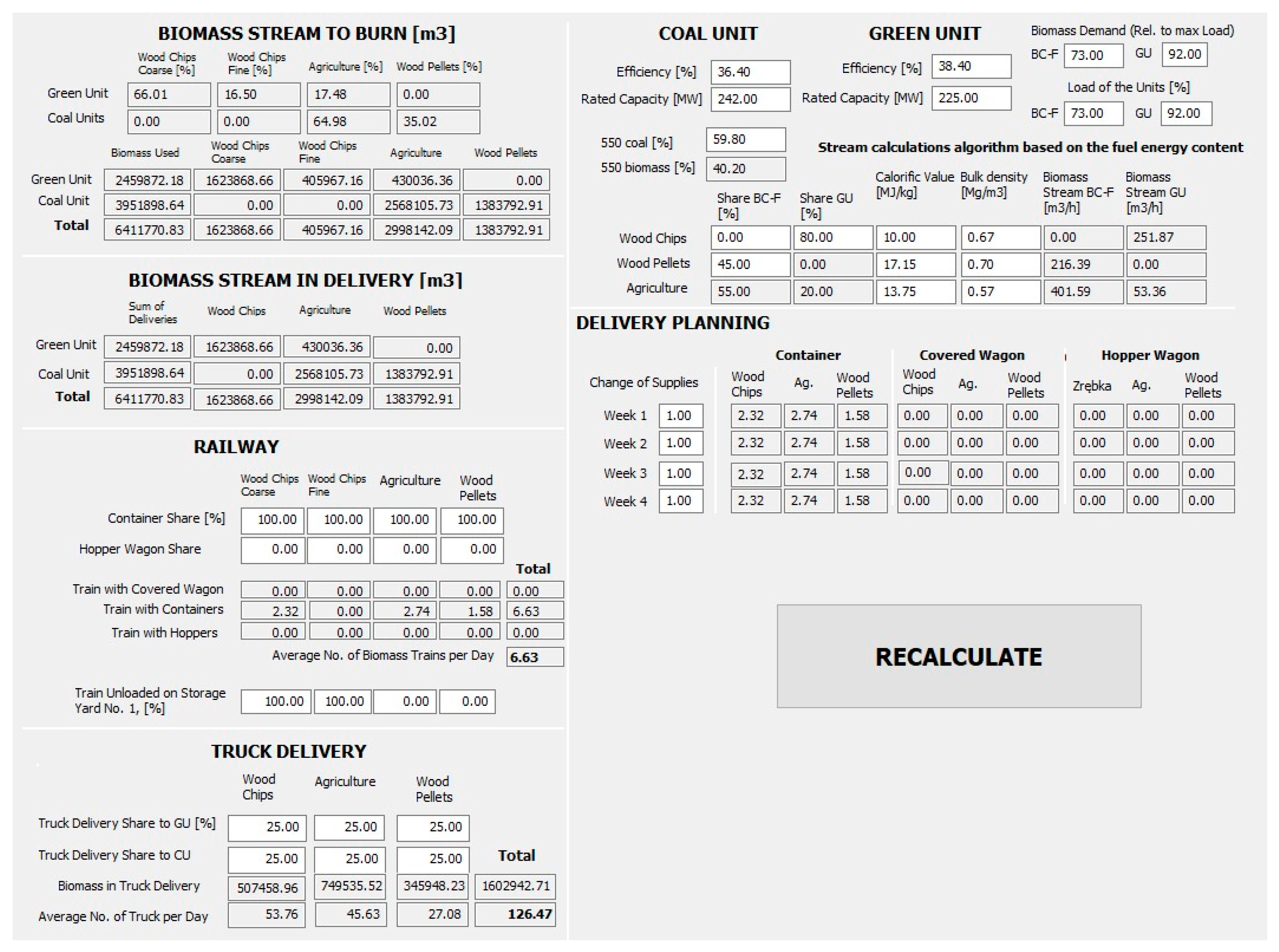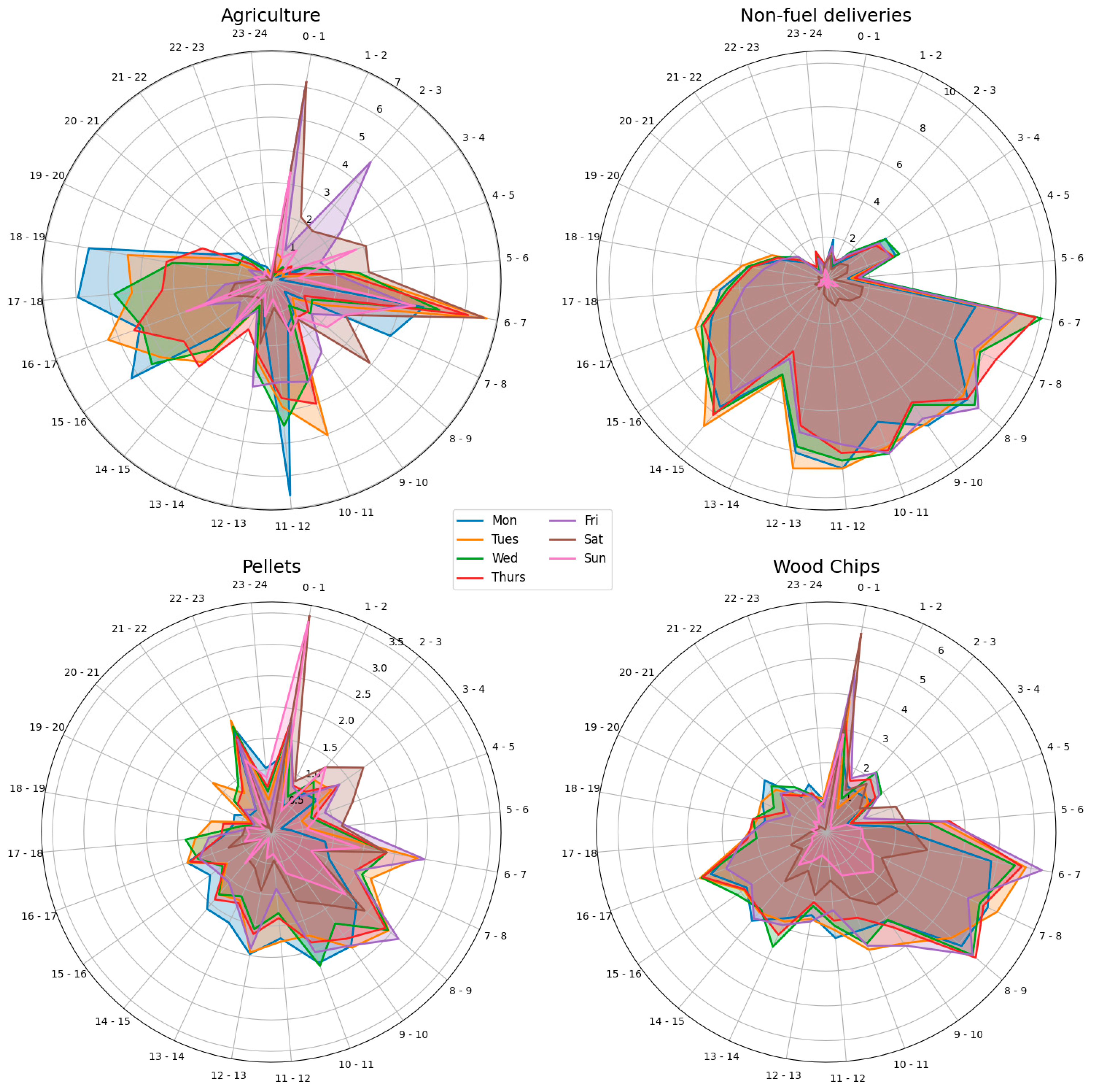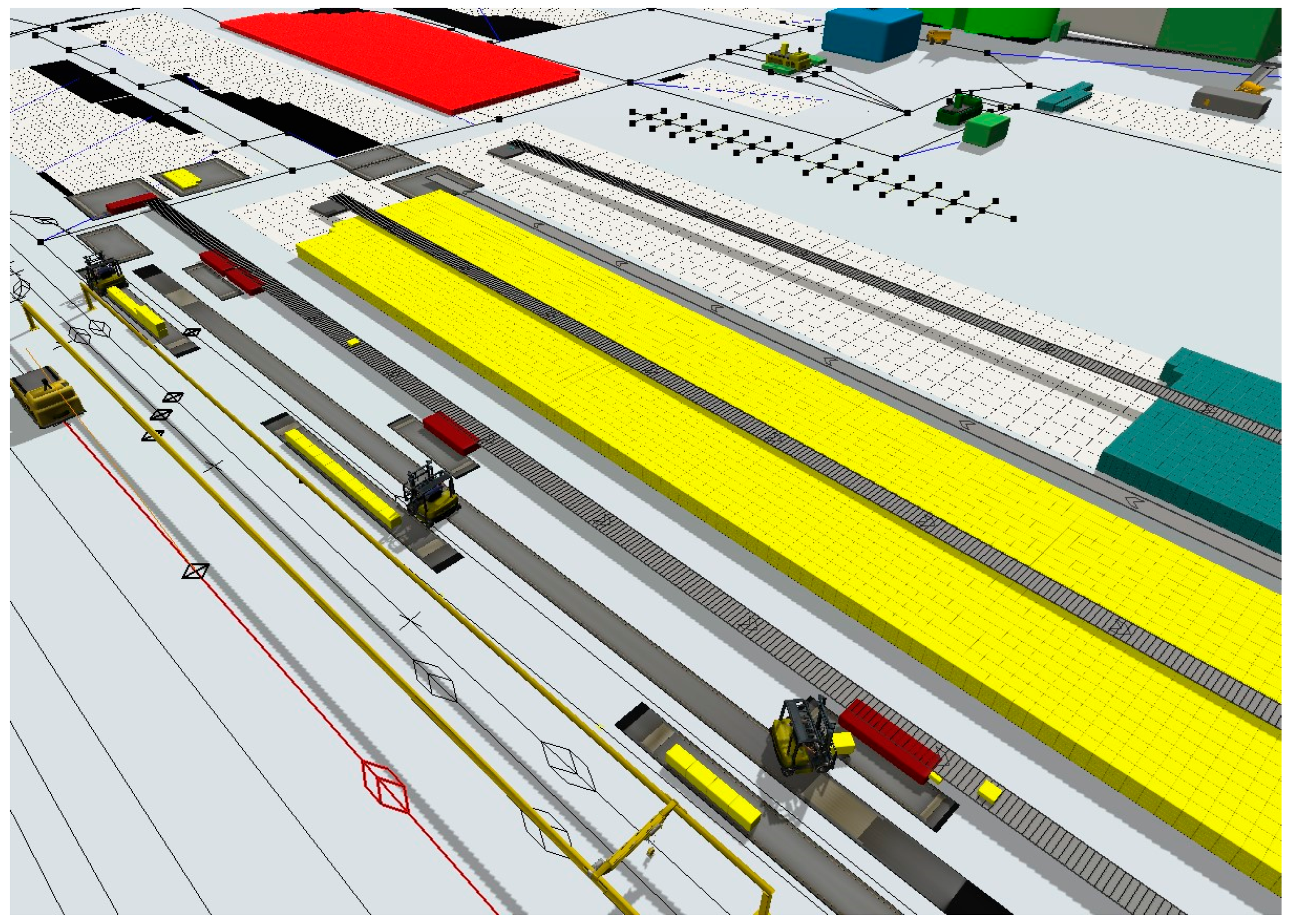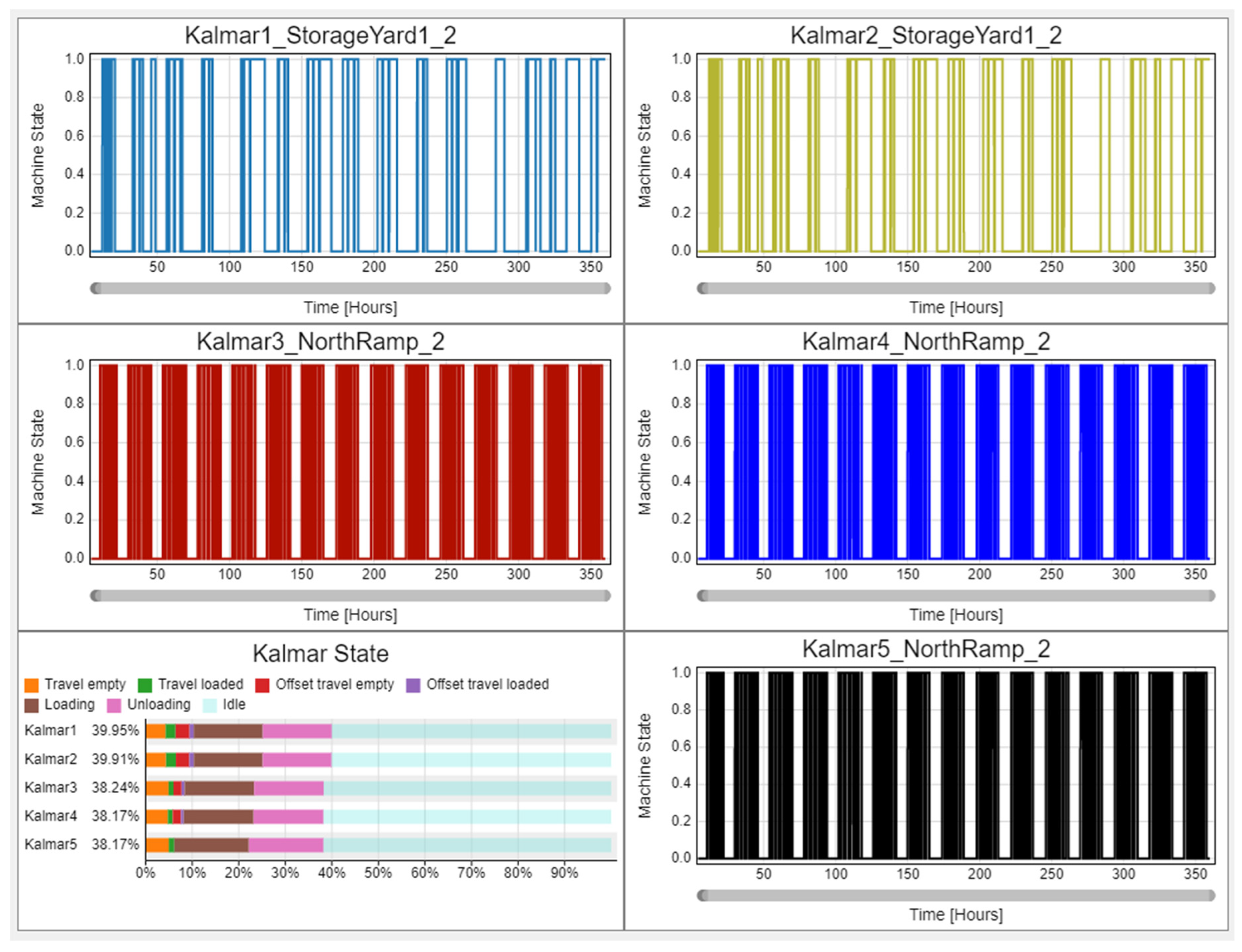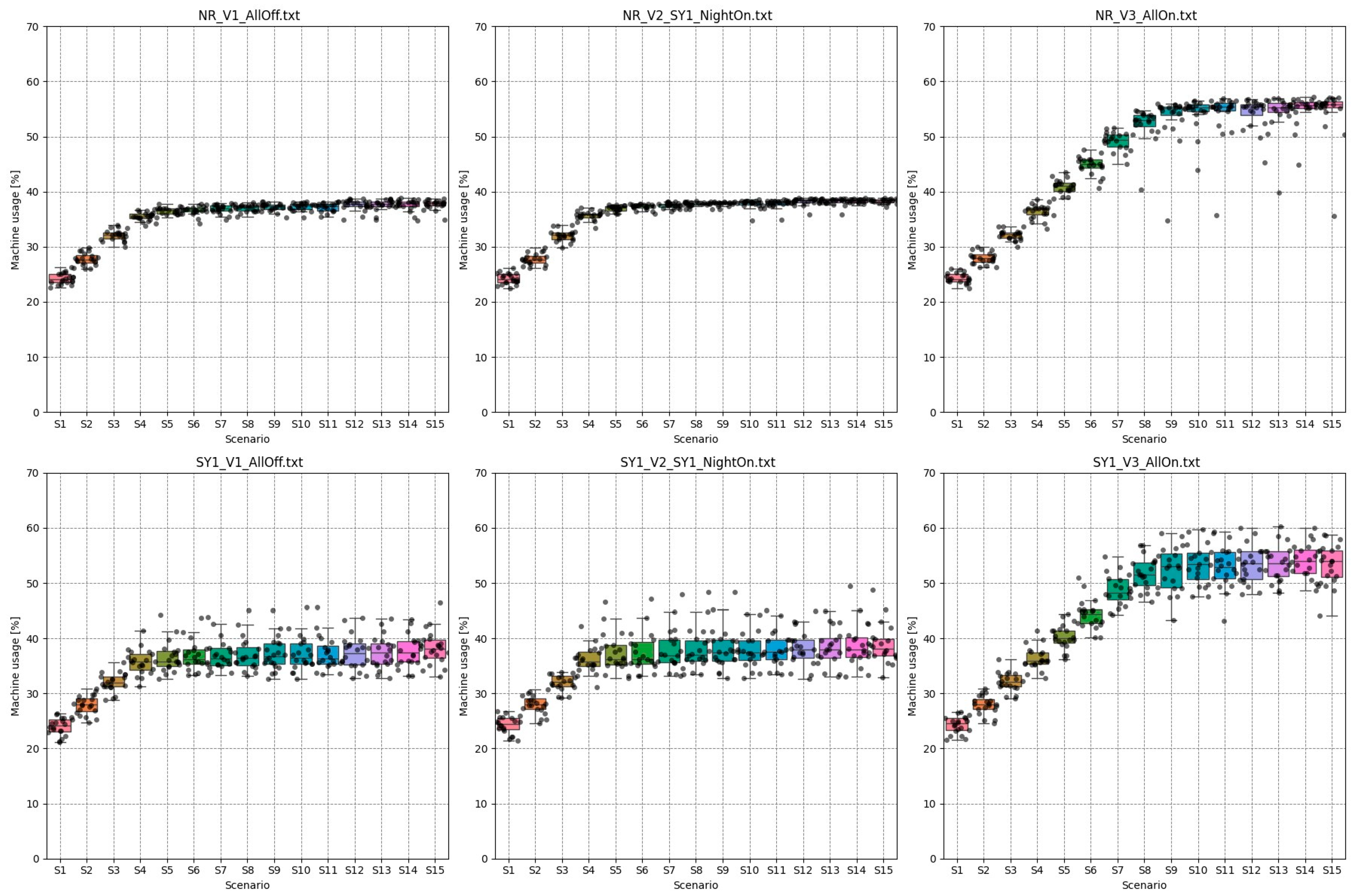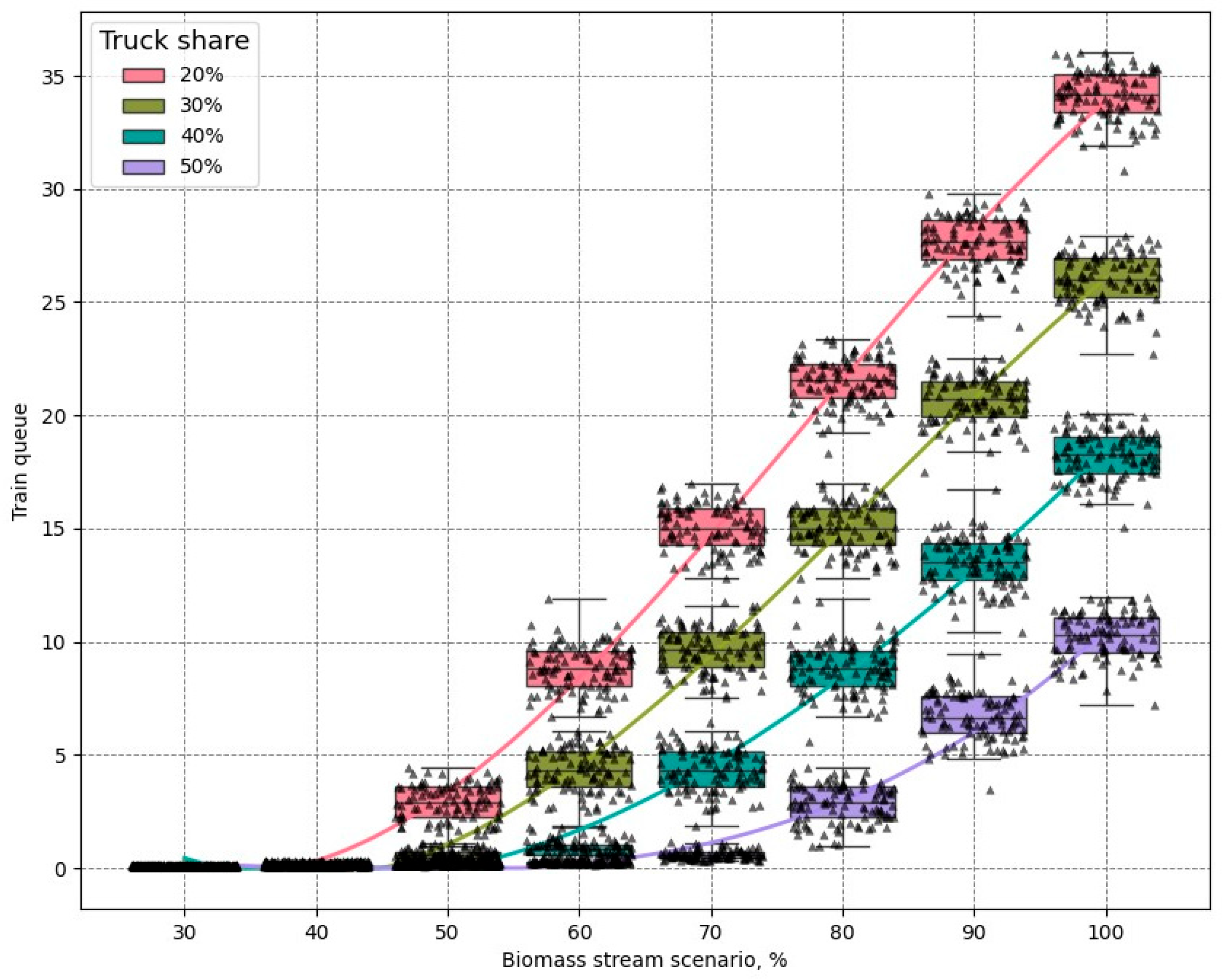1. Introduction
The decarbonization of electricity production is a complex process in many European countries [
1], for which it is necessary to ensure a secure supply of electric energy in the transition period when fossil-fueled power plants are being phased out [
2]. One of the methods for a systematic reduction in CO
2 emissions from an existing coal plant is its conversion to a multi-commodity one that burns various types of biomass [
3] mixed with or used instead of coal, including waste or poor quality coal [
4,
5], with the further possibility of adding RDF (refuse-derived fuel) [
6]. Because biomass is classified as a renewable energy source (RES), the CO
2 emissions from burning it are not included in carbon limits [
7]. Therefore the potential of biomass energy has been investigated globally [
8] and across the European Union [
9]. The availability of various types of biofuels with the trends of energy demand and the economy development rate have also been analyzed in China [
10]. The biomass and coal mix helps to achieve a level of 550 kg of CO
2 emitted per MWh—the provisional threshold value of carbon emission (derived from gas-fired power plants indexes) accepted in 2017 by the European energy companies that entitles any European power plant to obtain public support or financing from the banking sector [
11]. The replacement of coal with biomass results in a significant (2–3 times) increase in the volume of fuel supplied to the power plant units. These volumes of troublesome and even dangerous material (biomass is prone to fire and explosion or dampness) have to be unloaded from cargo trains or trucks, sampled to assign actual quality parameters [
5], safely stored in dedicated depots or silos, and eventually conveyed to the power units bunkers for burning with regard to the necessary proportion of the mixed types of biomass (e.g., wooden or agricultural pellet, industrial grain, seeds, etc.) to ensure the required calorific value and safe burning. An extensive internal system for transporting, in addition to logistic problems, may increase noise emissions [
12,
13]. Growing environmental requirements [
14] make it necessary to analyze the impact of this expansion on possible exceedance of the permissible levels.
For a comprehensive assessment of the concept of expanding the material handling and feeding system of the hard coal power plant undergoing conversion in Polaniec (located in the South-East Poland—50°26′17″ N 21°20′18″ E), implementing the new multi-commodity warehouses equipped with portal scraper reclaimers, belt conveyors, and silos (
Figure 1), a digital simulation model was built. The model was used to dimension system elements and verify the correctness of the solutions used [
5]. Then, a dedicated noise emission model was built for the purposes of mandatory environmental impact assessment procedures for the planned expansion of the transport system, which showed the possibility of exceeding the permissible noise levels at night in selected locations [
13].
The growing requirements for reducing CO
2 emissions are accompanied by other, increasingly stringent environmental requirements, which have resulted from EU Directives [
15]. In accordance with the IED Directive, the environmental impact of energy plants is limited by integrated permits for fuel combustion installations issued by the competent environmental protection authorities. They define emission limits in relation to the following, among others: dust, SOx, NOx, HCL, HF, and Hg. The values indicated in the integrated permits result from the BAT (Best Available Technique) conclusions for large combustion plants [
16] in accordance with [
15]. The BAT conclusions apply primarily to combustion installations with a total rated thermal power supplied as fuel of 50 MW or more. The fuels included in the BAT conclusions are in particular solid, biomass, liquid, and gaseous. The techniques described in the BAT conclusions are not prescriptive; other methods may be used provided they ensure at least an equivalent level of environmental protection. Energy plants must therefore adapt their functioning to the BAT conclusions dedicated to emissions to air and water (BAT-AELs), waste management, noise emissions, and energy efficiency. Subsequent publications of BAT conclusions for large combustion plants are systematically more restrictive, forcing energy producers to constantly take actions aimed at meeting the growing environmental requirements. Combined with these requirements are EU Directives setting the outlines for promoting the energy efficiency of the industry [
17,
18,
19].
In this article, the authors propose the application of a discrete event simulation method (DES) to analyze the impact of the proposed technological solution on the surroundings of the power plant. Discrete event simulation is the most commonly used in the analysis of logistical and industrial processes, primarily for identifying bottlenecks and evaluating system modification scenarios. It has been extensively utilized in the mining sector to address the complex challenges associated with the transportation of bulk materials.
Most publications on discrete event simulation concentrate on the analysis of specific case studies across a broad spectrum of application areas—including mining [
20,
21,
22] and various branches of industry [
23,
24] as well as occupational and human safety [
25,
26]—where the investigation required reconstruction of object states to ensure an accurate representation of system dynamics. In the field of biomass transportation, analysis can, due to the specific characteristic of this fuel, be conducted at multiple process levels, ranging from simple technological systems such as machine cooperation within power plants to international transportation and broader economic evaluations assessing process efficiency. The biomass supply chain has been analyzed for numerous types of fuels and across various economies to examine different technological and financial factors. The transportation of biomass using different types of vehicles (truck, train, or barge) was analyzed by Zahraee et al. [
27] to estimate the costs of delivery and greenhouse emissions in a case study conducted in Malaysia. Their model indicated that the best solution would be a combination of three modes of transport. The authors proposed an analysis period of nearly 50 years. A similar problem for Canadian power plants was presented in the study of Mobini et al. [
28], where a model for biomass procurement, transport, and processing was developed for a 20-year analysis period of estimating costs.
A biomass supply chain model, from raw material production (wood chips) to delivery to the power plant, was proposed by Pinho et al. [
29]. The model analyzed the impact of deviations in delivery execution caused by system component failure on the achievement of the plan outcomes focusing on a case study of a power plant located in Finland. It served to support decision-making regarding the allocation of resources necessary to the required quantity of biomass. Another example analyzed in Finland was a transportation chain model that considered the moisture content of biomass and transportation distance as key factors [
30]. These parameters significantly influenced the economics of the biomass procurement process in a system comprising one chipper and two trucks.
A comprehensive review of publications on biomass transport and delivery has been conducted in [
31]. Based on changes in the Bill of Materials, the authors analyzed environmental and financial Key Performance Indexes (KPIs) such as electricity, coal, and fuel consumption, CO
2 emissions, procurement expenses, and various shipping costs (from producer through port to customer). On this basis, they drew general conclusion regarding potential adjustments to the biomass supply chain in Vietnam such as the need for optimizing feedstock locations.
A similar issue was addressed using Dijkstra’s algorithm to analyze the optimal location for pellet delivery in Eastern Poland [
32]. In this context, a simulation model was not used, but it was demonstrated that suboptimal location choices could increase transportation costs by up to 75%. An analysis of the production and supply variant for wood pellets was also conducted for a Canadian case study, where the supply chain was examined in a top-down manner [
33]. This approach started with the destination of transportation and market price at the port, followed by an evaluation of transportation options and potential plant location, ultimately determining the profitability for a facility with potential production capacities ranging from 50,000 to 150,000 tons per year.
The solution presented in this article, regarding the determination of the required system workload during nighttime hours, is the first case known to the authors of applying a DES model to such a complex system within a single comprehensive model. The uniqueness of the presented solution lies in the integration, within a single model, of external system elements—including variable and unstable deliveries via multiple modes of transport, a large number of modeled storage yards, and biomass retrieval model that ensures a continues combustion to the power plant units. An additional distinctive feature of the analysis presented in this study is the inclusion of biomass co-firing with coal as a strategy to reduce taxable emissions and prolong the operational lifespan of powerplants. In contrast, the previously referenced studies did not consider such a technological configuration. Consequently, this work focuses on a specific case characterized by substantial logistical and environmental complexities. The implementation of the proposed model enables early identification of these issues at the pre-investment stage, providing a significant advantage in the decision-making process for the investors.
2. Materials and Methods
2.1. The Simulation Model Layout
The analyzed coal plant Polaniec was converted to a coal and biomass plant some years ago by adding a new biomass Green Unit and co-firing a relatively small amount of biomass with coal in the old Coal Units. In order to achieve the required level of 550 kg of emitted CO
2 per MWh (measured for each power unit independently) almost half of the chemical energy of the fuel should be obtained from RESs in Coal Units. These units should be retrofitted for this purpose. The planned schedule of upgrading Coal Units to burn increased amounts of biomass was included to the list of constraints for the development of the biofuel supply system (BSS) [
2]. The required increase in capacity of the BSS was addressed by the proposal of new warehouses, belt conveyors, and silos that are presented together with the existing ones on the conceptual model (
Figure 1 and
Figure 2). The performance of the final BSS and its interim (during the planned investment period) layouts were analyzed with the use of simulation methods [
34]. The dedicated model was created using Flexsim v.22.1.2, released 18 May 2022. FlexSim is a leading DES-based software used to model, visualize, and optimize complex systems across various industries. Through a combination of built-in simulation objects and custom scripting capabilities, it supports detailed analyses such as bottleneck identification, scenario evaluation, and system performance optimization. The model reproduced the end-to-end logistics of biomass and coal transportation in the power plant, using task duration metrics and biomass throughput volumes as the key parameters for representing the operational status of individual units.
The model was constructed using a bottom-up approach, replicating discrete technological operations, and was developed based on several sub-models of individual processes, the most significant of which included the following:
Truck deliveries (including the queue at the entrance gate, gate service, weighing, biomass quality sampling, unloading at the dedicated yard, re-weighing of the emptied truck, and leaving the power plant site);
Train deliveries (containing the train’s entrance to the Polaniec railway station and logistical operations on railroad tracks until the arrival of freight wagons at the dedicated ramps for unloading);
Belt conveyor operations with accompanying devices (silos and adjustable transfer stations);
An object work management model;
A stream calculation algorithm.
Each sub-model was subjected to separate verification and validation procedures. Model verification involved monitoring the behavior of individual entities to ensure accurate representation of technological processes. Validation proved to be significantly more challenging, as it required the simultaneous assessment of multiple operational indicators, taking into account the currently observed system performance. Particular attention was given to stock levels across all biomass storage yards, the control of fuel stream distribution, and the timing and accuracy of bunker refilling operations. Although these components were not bottlenecks due to their integration into a well-refined technological workflow, they nonetheless introduced limitations that restricted the flexibility of supply chain logistics—primarily as a result of time-sensitive and environmentally regulated unloading procedures.
The final model’s layout is shown in
Figure 2. The thicker lines with curves represent the railroad tracks for train deliveries, the thin lines with nodes at the connections indicate transportation routes for truck deliveries, and the gray, inclined vertical curvature straps show the 3-D belt conveyor routes (better recognizable on
Figure 1), while the two planned warehouses and empty biomass storage areas are represented by dotted rectangles.
On the
Figure 2 different colors represent distinct types of biomass—red (fine) and green (coarse) for wood chips, gray for wood pellets, and yellow for agriculture biomass. Rectangular white areas represent empty storage spaces while black areas are excluded from storage for technological reasons such as maneuvers of technological vehicles. Cubic shapes denote system installation objects. Some objects shown in the drawing exist only in the model because they are either planned or used to establish the working logic of the model.
2.2. The Simulation Model Settings and Control
In addition to the model space, a special control panel was created (see
Figure 3). It allows freely adjusting fuel flow settings and the determination of the parameters of the transport system. The calculation for biomass flow for each simulation variant begins with determining the parameters of power units including capacity, efficiency, and load. In subsequent model variants, the capacity and efficiency of the unit were considered as constant parameters. However, the flexibility of the model allows for adjusting these parameters as well. The parameter that directly influenced the flows is the unit load. In the simulation, depending on the specific model analyses, the regulation varied in scope up to 92% and 73% of the maximum capacity for the Green Unit and Coal Units, respectively (these limits were set according to plant production records [
5]).
In the same section, the quality parameters of fuels were defined. The proportions of individual fuel types allowed for determining the hourly (or daily) fuel flow to individual units. In the base scenario, the sum of the biomass flow to the blocks corresponded to the total required delivery which, after simply calculation, allowed us to determine the number of trains and trucks arriving at the powerplant. When testing subsequent solutions, the panel (in the Delivery Planning section) allowed for periodic adjustments to the number of trains (increasing or decreasing) by a specific percentage, making it possible to include cyclical changes in the number of train deliveries resulting from factors such as the biomass purchase and delivery plan or limitations in the capacity of the railway system.
The control panel also enables defining unloading locations. For train deliveries, the considered unloading locations were the existing ramp near storage yard, which handles deliveries to the Green Unit (marked as 1 in
Figure 2) and a proposal to construct a new unloading system in the northern part of the plant area (marked as 2 in
Figure 2).
An essential system regulation prior to model deployment was establishing the ratio of biomass deliveries transported by trucks to those delivered by trains as this indicator was crucial for determining the quantity of trucks and freight trains in the system.
Quantities of transport machines defined in the model were generated during the simulation in accordance with their daily and weekly biomass delivery frequencies. Deliveries by trucks were characterized by an increased number of arrivals in the morning and early afternoon with fewer deliveries on non-working days. The example of a daily truck delivery calculation shown in
Figure 3 is based on a truck delivery share of 25%. This share corresponds to 126 vehicles entries, categorized into 3 types of transported biomass. The biomass truck generators in the model were based on an exponential distribution, which, with a specified frequency (parameter
λ), varied for each hour of the day and each day of the week appearing at the power plant gate (
Figure 4).
The railway delivery cycle was generated in a somewhat different way due to the fact that railway deliveries are dependent on the railway traffic management system based on the train timetable. Consequently, railway deliveries contain a deterministic component, which in the model had to, for example, prevent the random appearance of two or more trains within a short time period. The solution to this issue was to generate railway deliveries based on individual railcars so that the time required to assemble the train corresponds to the delivery interval.
2.3. Applying the Night Mode of the BSS with Regard to Noise Limits
The regulation defined prior to the simulation, regarding the quantity of biomass and the locations of its unloading, determined the load on specific points within the system, directly impacting noise emissions at those locations. One of the tasks of the simulation model should therefore be the assessment of the impact of environmental protection constraints on the ability to handle the required biomass streams.
The analysis of possible noise emissions [
13] proved that some machinery equipment objects (belt conveyors) and some handling processes (unloading freight wagons) that are located in the northern area (marked 2 in
Figure 2) can exceed allowable limits during night hours. There are technical solutions (e.g., sound absorbing screens) to protect the neighborhood from excessive noise of unloading operations that can be applied against additional investment costs. These costs could be avoided if the BSS can supply a sufficient amount of biomass after applying the special nighttime modes—freezing some noisy operations. The BSS should therefore be analyzed against the need to freeze any operations in area 2 during night hours (since 10 p.m. till 6 a.m.). The simulations should help investigate the actual performance of the BSS with the forced night stops of the significant part of the planned BSS.
Object-oriented simulation models focus on queue analysis. In case of insufficient capacity at a specific point in the system, a queue emerges, indicating a mismatch in the system, pointing to an issue that requires correction. In the analyzed model the crucial element is the freight wagons queue, which forms when there is a lack of capacity for unloading freight wagons at the ramps. The queue of railway carriages, while not inherently an object of analysis, serves as an indicator that from a logistics perspective, there are performance-related challenges within the system at subsequent stages.
The essence of the process, which is analyzed in the model, has been depicted in
Figure 5. The unloading of containers from railway platforms is a bottleneck in the projected system because the pace of it determines the speed of handling subsequent trains. The model features a significantly high number of input parameters, with the most critical ones being the hourly or shift-based performance metrics of reach stackers. This, in turn, depends on the durations of individual technological activities such as the speed of lifting, dumping, and lowering containers as well as the distance of maneuvering movements. All of these variables are related to noise emissions so they should be minimized during each work period.
3. Results
In order to maintain an acceptable noise level generated by the unloading machines, conveyor belt system, and safety system, especially dust extraction, a solution was tested in the model involving periodic shutdown of the system. In the initial model assumption, continuous 24 h operation of the system was assumed. Incorporating environmental factors (previously described) necessitated the adoption of a new assumption and, consequently, its verification within the model.
The proposed unloading system at the northern ramp involved the use of three unloading points where three reach stackers, commonly referred to as ‘Kalmar’ machines, worked simultaneously. The loud operation of these machines results in their night-time shutdown. This leads to the shutdown of the planned biomass conveyor system and biomass stacking system. As a consequence, the ability to absorb the assumed biomass streams decreases. In mass service systems, the measure of system inefficiency is the queue in front of the service station. A similar assumption was made in the analysis of the biomass transport system, where the measure of the ability to handle deliveries was the queue of trains at the station.
The simulation was performed for a two-week delivery time. The modified parameters included setting the working time of unloading yards. Three operation modes of the biomass transport unloading system were considered:
M1: the restriction of night time operation;
M2: the restriction of night time operation only on the northern yard (No 2);
M3: unrestricted (around the clock) unloading at southern yard (No 1—existing storage) and northern yard (No 2—planned storage);
For each of the three systems, a simulation was carried out with 15 supply scenarios, which marked biomass flow level related to demand level (see
Table 1). The minimum supply level was set to 30% of the maximum load of power units up to the biomass quantity covering the load of operating blocks at their maximum capacity. Operating blocks at the maximum capacity for an extended period is not feasible. However, the experiment does not aim to test the combustion system’s efficiency but rather the delivery system. The reference point for the biomass stream in the model has always been the reported demand from the block operator.
As a result, the quantities of biomass corresponding to scenarios 10–15 should be considered improbable. However, they did confirm the model’s adequacy for analyzing various, including extreme, scenarios.
Figure 6 presents the simulation results for the main unloading arrangements. The first step of the experiment was to deactivate all unloading yards at night. The model’s response indicates that up to the level of the third scenario (biomass stream determined as 40% of the maximum), the wagons are still being unloaded continuously. After exceeding the 40% maximum load capacity, each subsequent increase of 5% in the biomass stream generates an increase in the queue by three trains (one hundred twenty freight wagons).
The above chart shows that in the case of a significantly limited output of the power plant (due to the rising increase in the RES share in the domestic power mix) the BSS operations of unloading freight wagons could be stopped during night hours in the case of deliveries smaller than those for Scenario 4, corresponding to the entry of, on average, 3.7 trains and 70 trucks carrying biomass per day.
The difference between the model with the southern yard operating 24/7 (M2) and the model with its shutdown (M1) did not cause significant changes in queues. This results from the adopted assumption regarding the distribution of specific types of biomasses to particular yards, allowing detailed monitoring of delivery locations. Another reason is that the model was constructed for the existing system, and relative changes in the consumption of fuel types are not proportional (coal boilers are not adopted for the mass combustion of wood chips, while an increase in energy production from co-firing was assumed). This leads to situations where the southern yard (SY1) does not receive deliveries because it becomes blocked by track occupancy or freight handlers due to the deliveries that can only be unloaded at the northern yard, which are waiting because operations are halted during quiet hours. In consequence, in the case of nighttime shutdown of the northern yard, train sets cannot be reliably unloaded using the FIFO (First In, First Out) method.
The third model (M3) indicates the ability to accept train sets in the case of implementing a night shift at the level of Scenario 8. Considering the capacity of siding at the station before the powerplant and the possibility of retaining deliveries at the level of several train sets, the limit of acceptance capacity, given the adopted technical parameter of the model, is around Scenario 11, which corresponds to a capacity of 13,300 cubic meters of biomass per day.
The bottleneck in the system is the unloading of biomass from freight cars using reach stackers. For the scenarios shown in the table, the machine operating modes have been summarized in a simplified manner. Seven operating modes have been distinguished, i.e., travel empty, loading, travel loaded, unloading, and two offset modes for loading and unloading, and these have been summed up as time marked as work mode. Subsequently for the entire simulation period, this work mode time was accumulated and in relation to the clock time, it indicated the total operating time of the machine.
An example of the dashboard from the running simulation has been presented in
Figure 7. For the 5 reachstackers: two at storage yard 1 and three for the north ramp the workload for each working hour over two weeks of simulation was shown. On the presented example, the daily work cycle of the machines for the northern ramp is clearly visible in the form of 14 equal intervals.
The collected simulation results for workloads of all variants across the successive scenarios is shown in
Figure 8. The two graphs on the left show the workload of the reach stackers for the northern ramp (NR, upper half of the graph) and storage yard 1 (SY1, lower half) in the case of nighttime shutdown of the machines. The simulation results for the northern ramp are significantly more stable (smaller range). This is related to the dedicated workstation with a high capacity and relatively short transport distance.
Yard 1 handles deliveries of wood chips, the quantity of which does not significantly increase. The access route for the railway cars is much longer and takes more time (shifting split freight trains into 10-car sets). The variability in deliveries in the case of accumulation or a lack of deliveries over an extended period leads to a greater range of simulation outcomes.
The workloads of Kalmars in yard 1 and yard 2 differ. Due to the deactivation of night operations in yard 2, there are regular breaks in the charts generated for Kalmars 3, 4, and 5. During daily shifts, however, these Kalmars operate almost continuously due to the other pieces of carefully designed logistic equipment of the BSS: easy access to freight wagons, conveniently located feeding points of receiving conveyors (
Figure 4), flexible layout of the belt conveyor system that delivers the unloaded biomass either to the high-capacity warehouses or directly to the silos before the coal units (
Figure 2). Kalmars 1 and 2 in yard 1 workloads depend on less regular arrivals of trains with wood chips, predominantly delivered by trucks.
All the above results of simulations were made for a fixed proportion of truck and rail deliveries of biomass (1:3). However the proportion can vary and is subject to the actual policy of orders of biomass suppliers [
5]. Following the (less probable) needs exceeding the biomass stream level of scenario S8, the managers of Polaniec can increase the orders for truck deliveries. Truck deliveries are more flexible than the train ones and can be considered as a supply reserve available on demand.
The results presented in box-and-whisker plots of the number of unloaded biomass freight wagons (
Figure 6 and
Figure 9) need to be compared with one another because they seem to be very similar. In order to distinguish the differences between these modes of night shifts, the most interesting scenarios S3–S9, which correspond to the most expected range of biomass volume supply (according to [
11,
15,
16]), are shown in the
Table 2. The red color in the
Table 2 indicates scenarios that exceed the capacity to accept the given biomass flow, while the gray color represents the threshold at which an increasing queue can be observed, which, after a prolonged period of increased delivery flow, will lead to surpassing the railway siding capacity.
The unloading ramp bottleneck simulation results considering flexible delivery load planning are presented in
Table 3. Increasing the share of truck deliveries from 20 to 50% ensures the daily biomass flow at the level on scenario 9. An analogous color scheme was used to indicate the acceptable delivery level. The difference related to the option of flexibility in changing modes of transport allows for an increase in deliveries by approximately 1700 m
3 of biomass per day.
5. Conclusions
The article presents the results of a simulation analysis on the efficiency of the biomass transport system in a power plant located in an urbanized environment, taking into account potential shutdowns of facilities generating too much noise at night. The use of digital spatial simulation models of a complex, cyclical, and continuous transport system to control its operation in conditions of constraint is an effective method of solving environmental conflicts at the design stage of the extension of industrial installations in urbanized areas.
With the use of the dedicated simulation model of the biofuel supply system (BSS) in the Polaniec plant, the alternative modes of its work (with and without forced night stoppages of the selected part of the BSS) were analyzed. An increased share of truck deliveries can address the needs of the assumed maximum biomass volume supply even when the freight trains are not unloaded in the night and no additional investments on sound absorbing screens are necessary. This scenario represents the current trend of confined electric energy production at the Polaniec plant (and other thermal plants) as the growing RES installed power is preferred by the national regulator.
However in the case of an increased demand of electric energy production by the Polaniec plant, the simulations results have proved that even an increased share of truck deliveries will not be sufficient if freight trains are not unloaded in the night. Then the additional technical solutions mentioned in the paper should be considered.
The application of the DES model to the planned extension of the BSS in order to lower the carbon footprint of the existing coal plant to the temporary acceptable level of gas plants has enabled us to prove the feasibility of this plan with regard to the requirements of noise limits.
The biggest advantage of the presented approach is the fact that the built DES model is ready to use for further analysis of the other “what-if” scenarios according to rapidly changing energy market regulations and limitations.


